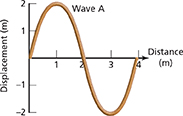CHAPTER 17 Assessment
Reviewing Content
Choose the letter that best answers the question or completes the statement.
Which of the following is NOT true about mechanical waves?
They carry energy.
They transfer matter.
They can be longitudinal.
They require a medium.
In a transverse wave, the medium vibrates
at right angles to the wave direction.
in the same direction as the wave.
in a direction opposite that of the wave.
at a 45° angle to the wave direction.
The height of a wave crest is called
wavelength.
frequency.
amplitude.
energy.
For waves moving at a constant speed, if wavelength is doubled, then frequency is
doubled.
halved.
unchanged.
quadrupled.
When a wave is reflected, its speed
increases.
increases or decreases.
decreases.
is unchanged.
When a wave bends around an obstacle, it is called
reflection.
refraction.
diffraction.
interference.
When two waves interfere, the displacement where two troughs meet is
positive.
negative.
zero.
a crest.
A large speaker is better than a small speaker for producing sounds with
low frequency.
high frequency.
low intensity.
high intensity.
The highest-frequency sound human ears can usually hear is about
20 Hz.
10,000 Hz.
20,000 Hz.
30,000 Hz.
Sonar can make use of
the Doppler effect.
ultrasound.
infrasound.
resonance.
Understanding Concepts
Name two kinds of longitudinal waves and explain how you know they are longitudinal.
How are some surface waves similar to both transverse and longitudinal waves?
Copy the diagram below on a separate piece of paper and use it to answer Questions 13–15.

On your diagram, draw wave B with the same wavelength as wave A, but twice the amplitude.
On your diagram, draw wave C with the same amplitude as wave A, but twice the wavelength.
How does the frequency of wave C compare with the frequency of wave A, assuming they travel at the same speed?
What causes refraction of a wave as it enters a new medium at an angle?
Regardless of the direction of waves far from an island, waves close to the island move toward the shore on all sides. Explain.
Why does a node in a standing wave have zero displacement?
How is intensity different from loudness?
Explain why a fire engine's siren sounds lower in pitch after the fire engine passes you.
What is the function of the eardrum?
What are the names of the three small bones in the middle ear, and what is their purpose?
Why are the materials used in construction of a concert hall important?





